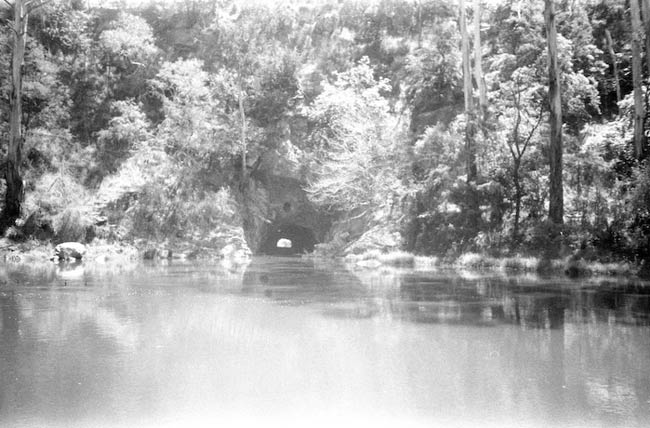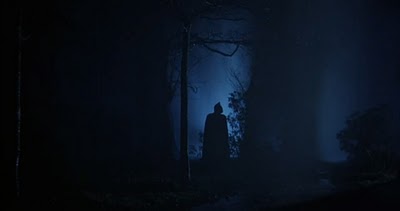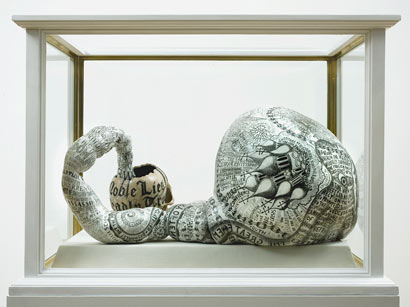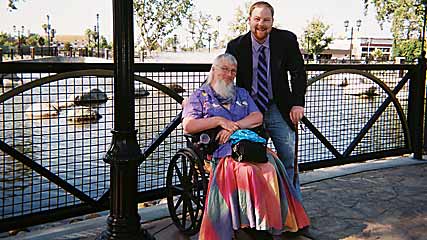mystery and paranormal

{ Woman eats entire cutlery set | Thanks Kaleigh }
related { Pica is the craving or ingestion of nonfood items. The cravings found in patients diagnosed with pica may be associated with a nutritional deficiency state, such as iron-deficiency anemia; with pregnancy; or with mental retardation or mental illness. The word pica is derived from the Latin word for magpie, a species of bird that feeds on whatever it encounters. | Encyclopedia of Mental Disorders }
food, drinks, restaurants, mystery and paranormal | January 13th, 2011 11:40 am

NASA has discovered a completely new life form that doesn’t share the biological building blocks of anything currently living in planet Earth. This changes everything. (…) NASA scientist Felisa Wolfe Simon will announce that they have found a bacteria whose DNA is completely alien to what we know today. Instead of using phosphorus, the bacteria uses arsenic.
{ Wired | Continue reading }
Scientists said Thursday that they had trained a bacterium to eat and grow on a diet of arsenic, in place of phosphorus — one of six elements considered essential for life — opening up the possibility that organisms could exist elsewhere in the universe or even here on Earth using biochemical powers we have not yet dared to dream about.
The bacterium, scraped from the bottom of Mono Lake in California and grown for months in a lab mixture containing arsenic, gradually swapped out atoms of phosphorus in its little body for atoms of arsenic.
Scientists said the results, if confirmed, would expand the notion of what life could be and where it could be. “There is basic mystery, when you look at life,” said Dimitar Sasselov, an astronomer at the Harvard-Smithsonian Center for Astrophysics and director of an institute on the origins of life there, who was not involved in the work. “Nature only uses a restrictive set of molecules and chemical reactions out of many thousands available. This is our first glimmer that maybe there are other options.”
{ NY Times | Continue reading }
photo { Jackson Eaton }
mystery and paranormal, science | December 2nd, 2010 2:37 pm

Stuxnet is an incredibly advanced, undetectable computer worm that took years to construct and was designed to jump from computer to computer until it found the specific, protected control system that it aimed to destroy: Iran’s nuclear enrichment program.
Intelligence agencies, computer security companies and the nuclear industry have been trying to analyze the worm since it was discovered in June by a Belarus-based company that was doing business in Iran. And what they’ve all found, says Sean McGurk, the Homeland Security Department’s acting director of national cyber security and communications integration, is a “game changer.”
The construction of the worm was so advanced, it was “like the arrival of an F-35 into a World War I battlefield,” says Ralph Langner, the computer expert who was the first to sound the alarm about Stuxnet. (…)
The target was seemingly impenetrable; for security reasons, it lay several stories underground and was not connected to the World Wide Web. And that meant Stuxnet had to act as sort of a computer cruise missile: As it made its passage through a set of unconnected computers, it had to grow and adapt to security measures and other changes until it reached one that could bring it into the nuclear facility.
When it ultimately found its target, it would have to secretly manipulate it until it was so compromised it ceased normal functions.
And finally, after the job was done, the worm would have to destroy itself without leaving a trace.
Here’s how it worked, according to experts who have examined the worm:
–The nuclear facility in Iran runs an “air gap” security system, meaning it has no connections to the Web, making it secure from outside penetration. Stuxnet was designed and sent into the area around Iran’s Natanz nuclear power plant — just how may never be known — to infect a number of computers on the assumption that someone working in the plant would take work home on a flash drive, acquire the worm and then bring it back to the plant.
{ Fox News | Continue reading | Thanks Cole! }
mystery and paranormal, technology | December 1st, 2010 10:51 pm

For most of history, psychologists thought of the study of siblings as backwater: Parenting was important — siblings were not.
Then in the 1980s, a researcher named Robert Plomin published a surprising paper in which he reviewed the three main ways psychologists had studied siblings: physical characteristics, intelligence and personality. According to Plomin, in two of these areas, siblings were really quite similar.
Physically, siblings tended to differ somewhat, but they were a lot more similar on average when compared to children picked at random from the population. That’s also true of cognitive abilities.
“The surprise,” says Plomin, “is when you turn to personality.”
Turns out that on tests that measure personality — stuff like how extroverted you are, how conscientious — siblings are practically like strangers.
In fact, in terms of personality, we are similar to our siblings only about 20 percent of the time. Given the fact that we share genes, homes, routines and parents, this makes no sense. What makes children in the same family so different? (…)
No one knows for sure, but there are three major theories.
{ NPR | Continue reading }
photo { Katie Shapiro }
mystery and paranormal, psychology | November 29th, 2010 7:05 pm

The discovery that natural clay forms a protective shell around tiny air bubbles has profound implications for our theories about the origin of life on Earth.
One of the great mysteries in biology is the origin of cell membranes, the protective layers that completely surround the complex chemical soup in which many of life’s most delicate processes take place.
DNA and its attendant biochemical machinery can only operate in the carefully controlled environment that the cell membrane creates. But curiously, one of the important jobs that this machinery does is to create the chemical building blocks that then self-assemble into the membrane itself. So that creates a paradox: the membrane cannot form without the biochemical machinery but this will not work without the protection of the cell membrane.
The puzzle is which came first. How could cell membranes have evolved without biochemical machines to manufacture the building blocks? And alternatively, how could the biochemical machines have evolved without the crucial protection that cell membranes provide? It’s a chicken and egg problem.
In recent years, an answer has emerged. It very much looks as if the cell membranes came first and the evidence comes from numerous studies that show how simple organic molecules can self-assemble into bubble-like structures called vesicles.
Various groups have shown how these vesicles can form not only in the prebiotic soup that probably existed early in Earth’s history but also on the surface of ultracold crystals that we know to exist in interstellar space.
By this way of thinking, the vesicles provided a protective environment in which the molecules of life slowly evolved.
Today, we get another option. Anand Bala Subramaniam at Harvard University and a few pals have discovered that this process of vesicle formation also happens in a naturally occurring clay called montmorillonite. That’s the kind of stuff that might clogg your boots after a hike.
{ The Physics arXiv Blog | Continue reading }
artwork { Dominic McGill }
mystery and paranormal, science | November 29th, 2010 6:10 pm

Pont St. Esprit is a small town in southern France. In 1951 it became famous as the site of one of the most mysterious medical outbreaks of modern times.
As Dr’s Gabbai, Lisbonne and Pourquier wrote to the British Medical Journal, 15 days after the “incident”:
The first symptoms appeared after a latent period of 6 to 48 hours. In this first phase, the symptoms were generalized, and consisted in a depressive state with anguish and slight agitation.
After some hours the symptoms became more clearly defined, and most of the patients presented with digestive disturbances… Disturbances of the autonomic nervous system accompanied the digestive disorders-gusts of warmth, followed by the impression of “cold waves”, with intense sweating crises. We also noted frequent excessive salivation.
The patients were pale and often showed a regular bradycardia (40 to 50 beats a minute), with weakness of the pulse. The heart sounds were rather muffled; the extremities were cold… Thereafter a constant symptom appeared - insomnia lasting several days… A state of giddiness persisted, accompanied by abundant sweating and a disagreeable odour. The special odour struck the patient and his attendants.
In total, about 150 people suffered some symptoms. About 25 severe cases developed the “delirium”. 4 people died “in muscular spasm and in a state of cardiovascular collapse”; three of these were old and in poor health, but one was a healthy 25-year-old man.
{ Neuroskeptic | Continue reading }
flashback, health, mystery and paranormal | November 29th, 2010 4:00 pm

When people are anxious they release a chemical signal that’s detectable on a subconscious level by those close to them. That’s the implication of a new study that collected sweat from people as they completed a high-rope obstacle course, and then tested the effect of that sweat on study participants as they played a gambling game.
Katrin Haegler’s team placed the sweat samples inside odourless tea bags which were attached with an elastic band to the underside of the gambling participants’ noses. For comparison, the participants were also exposed to sweat collected from non-anxious riders of an exercise bike.
When exposed to the anxious sweat, the participants took longer to decide over, but were more likely to bet on the highest risk scenarios. (…) In other words, the detection of another person’s anxiety made them more willing to take risks. Quite why this should be remains unclear.
{ BPS | Continue reading }
photo { Gary Lee Boas }
mystery and paranormal, olfaction, psychology | November 28th, 2010 12:05 pm

Light is special. In our everyday experience it behaves like a wave, which gets reflected, refracted and shows interference with other light of the same wavelength.
At the same time, light also consists of particles, so-called photons.
This duality is quite fundamental: the Hanbury Brown and Twiss experiment for example only works because of the particle-like properties of light.
This amazing and perhaps confusing duality, where light in one experiment appears to be a wave and in others it behaves like particles, is now laid bare in a paper published in Nature.
There, Jan Klaers, Martin Weitz and colleagues from the University of Bonn in Germany take one of the classical properties of light waves and turn it upside down — by demonstrating a related effect that only works when considering the particle qualities of light.
{ Joerg Heber | Continue reading }
photo { Valerie Chiang }
mystery and paranormal, science | November 24th, 2010 6:14 pm

In an interesting display of Greco-Turkish friendship, visitors from the Greek mainland joined with locals in the coastal Aegean village of Yagcilar as they gathered to watch bulldozers and men with shovels move in on the former home of a Greek Orthodox priest.
Under normal circumstances the demolition of a holy man’s home and the excavation of his garden would have prompted political commentary, but in this case the events had been arranged collaboratively by the current Turkish landowners, the great grandchildren of the exiled priest, the Ministry for Culture and Antiquities, and the governor of the district of Urla.
The aim of the excavators was to uncover 400 kilograms of gold and money buried in the garden in the mid-1920s for safekeeping. It had been entrusted to the priest by his religious community as they found themselves forced to evacuate Greece in the exchange of population that took place at the time.
The tip on the whereabouts of the treasure came from a diary entry found by the priest’s descendents, in which he indicates that he hid the money on the grounds of his house. After three days of searching, nothing but dirt was unearthed, leaving the treasure hunters with suspicions that the priest may have protected the treasure with a special spell.
In desperation, Turks called in a well known local hoca, a local religious leader, to pray at the site. Eyyup Hoca directed the operation to new areas to in which to dig and, with the second excavation attempt coming out empty-handed, he announced that jinn (fairies or imps) had changed the hiding place of the money every 41 years since the date of its burial. This was accepted as a reasonable explanation, and the quest continues.
The concept and existence of jinn is widely accepted in Islam. God is said to have created the jinn before humans from “hot wind” and “smokeless fire”, and some jinn are Muslim. Like humans they were invested with intellect, discrimination, freedom and the power to choose between right and wrong. They live all over earth on a separate plane of existence from man and cannot easily be seen, though they are often thought to take the shape of snakes and black dogs.
It is believed that some areas are particularly attractive to jinn - deserts, ruins and places of impurities such as dunghills, bathrooms and graveyards - but jinn can quite easily live alongside humans in their homes.
{ Asia Times | Continue reading }
asia, mystery and paranormal, weirdos | November 24th, 2010 5:15 pm

On October 25, family members of a 22-year old Malaysian woman reported her disappearance to police and that the woman had sent them a text message stating that she was being held captive by orang bunian (fairies).
This was not the first disappearance for Siti Balqis Mohd Noor. She had previously reported multiple “strange experiences” in which she apparently vanished into thin air and was later found in unexpected places, including the roof of her house, a nearby cement mixer, and a cemetery ten kilometers from her home. After all of these occurrences, Siti would report that she had no memory of what had happened.
{ Providentia | Continue reading }

NPR has a fascinating segment about how humans can’t walk in a straight line unless we have an external guide. We just end up walking in circles.
It turns out, no one is really sure why this happens but experiments on walkers, drivers and swimmers have all found the tendency to circle back on ourselves despite us thinking that we’re maintaining a steady course ahead.
{ Mind Hacks | Continue reading }
photos { Jean-François Lepage | Jeff P. Elstone II }
mystery and paranormal, photogs, science | November 23rd, 2010 4:55 pm

…areas of science, technology and medicine that are regressing. (…) I mean fields of research that actually go backward, as measured by some specific benchmark. Some examples:
* The end of infectious disease: Decades ago antibiotics, vaccines, pesticides, water chlorination and other public health measures were vanquishing diseases such as malaria, yellow fever, polio, whooping cough, tuberculosis and smallpox, particularly in First World nations. (…) Hopes for the end of infectious disease were soon crushed, however, by the emergence of AIDS, mutant flu viruses and antibiotic-resistant forms of old killers such as tuberculosis. (…)
* The origin of life: In 1953 Harold Urey of the University of Chicago and his graduate student Stanley Miller simulated the “primordial soup” in which life supposedly began on Earth some four billion years ago. They filled a flask with methane, ammonia and hydrogen (representing the primordial atmosphere) and water (the oceans) and zapped it with a spark-discharge device (lightning). The flask was soon coated with a reddish goo containing amino acids, the building blocks of proteins. This famous experiment raised the hopes of many scientists that one of nature’s deepest mysteries—genesis, the origin of life on Earth—would soon be replicated in the laboratory and hence solved. It hasn’t worked out that way. Scientists have failed to show how mere chemicals can become animate, and the origin of life now appears more improbable and mysterious than ever.
{ John Horgan/Scientific American | Continue reading }
artwork { Barnett Newman, The Promise, 1949 | Oil on canvas | Whitney Museum of American Art, New York }
health, mystery and paranormal, science, transportation, uh oh | November 17th, 2010 9:11 pm

I was reading my feed the other day and an article called “Having oral sex increases likelihood of intercourse among teens” came up. Naturally, the first thing that came to mind was “No shit”. The second was “How could someone get paid for researching this?” (…)
This study isn’t alone in the obviousness of its results:
▪ “Spouses with identical residential addresses before marriage: an indicator of pre-marital cohabitation.“, showing that the majority of English and Welsh newly-weds live together before marriage;
▪ “Don’t want to show fellow students my naughty bits: medical students’ anxieties about peer examination of intimate body regions at six schools across UK, Australasia and Far-East Asia”, showing that first year med students don’t like their classmates formally examining their genitals and breasts.
▪ “Determinants and consequences of female attractiveness and sexiness: realistic tests with restaurant waitresses.“, showing that more attractive waitresses get more tips.
{ Disease of the Week | Continue reading }
photo { Hannah Davis }
mystery and paranormal, science | November 15th, 2010 8:03 pm

We’d like to believe that most of what we know is accurate and that if presented with facts to prove we’re wrong, we would sheepishly accept the truth and change our views accordingly.
A new body of research out of the University of Michigan suggests that’s not what happens, that we base our opinions on beliefs and when presented with contradictory facts, we adhere to our original belief even more strongly.
The phenomenon is called backfire.
{ NPR | Continue reading }
photo { Sandy Carson }
mystery and paranormal, psychology, uh oh | November 13th, 2010 1:29 pm

Undoubtedly you have heard that dogs can sense earthquakes before the tremors occur. While anecdotes are common, experimental evidence supporting these claims remains elusive. The USGS in the 1970′s even examined the ability of animals for prediction “but nothing concrete came out of these experiments.”
Cueing on changes in the weather is frequent among the animal kindgom. Indeed, the daily, seasonal, and annual cycles of animals are triggered to changes in temperature, day length, precipitation, among a host of other environmental cues. But predicting the weather changes including large catastrophic weather events such as cyclones and hurricanes may be of another ilk.
Being able sense an oncoming major hurricane or cyclone would prove an invaluable trait for animal. Storm surges can both decimate and rearrange marine habitats especially in coral reefs. (…)
In 2009, the typhoon Morakot passed over the Philippines, Taiwan and eventually mainland China. (…) Researchers counted sea snakes in the coastal area before (July), directly before (August 5-6, labelled during below), and after the typhoon (August 12-17th). (…)
Data suggests that snakes senses the approach of the typhoon even before it made landfall.
{ Deep-Sea News | Continue reading }
photo { Stuart Robertson Reynolds }
incidents, mystery and paranormal, reptiles, science | November 12th, 2010 12:20 pm

Sweating sickness, also known as the “English sweate” (Latin: sudor anglicus), was a mysterious and highly virulent disease that struck England, and later continental Europe, in a series of epidemics beginning in 1485. The last outbreak occurred in 1551, after which the disease apparently vanished. The onset of symptoms was dramatic and sudden, with death often occurring within hours. Its cause remains unknown. One suspect is a hantavirus. (…)
The symptoms and signs as described by Caius and others were as follows: The disease began very suddenly with a sense of apprehension, followed by cold shivers (sometimes very violent), giddiness, headache and severe pains in the neck, shoulders and limbs, with great exhaustion. After the cold stage, which might last from half an hour to three hours, the hot and sweating stage followed. The characteristic sweat broke out suddenly without any obvious cause. Accompanying the sweat, or after that was poured out, was a sense of heat, headache, delirium, rapid pulse, and intense thirst. Palpitation and pain in the heart were frequent symptoms. No skin eruptions were noted by observers including Caius. In the final stages, there was either general exhaustion and collapse, or an irresistible urge to sleep, which Caius thought to be fatal if the patient was permitted to give way to it. One attack did not offer immunity, and some people suffered several bouts before succumbing.
The malady was never seen again in England after 1578 although a similar illness, known as the Picardy sweat, occurred in France between 1718 and 1861, but was less likely to be fatal and was accompanied by a rash, which was not a feature of the earlier outbreaks.
The cause is the most mysterious aspect of the disease. Commentators then and now put much blame on the general dirt and sewage of the time, which may have harboured the source of infection. (…)
Relapsing fever has been proposed as a possible cause. This disease, which is spread by ticks and lice, occurs most often during the summer months, as did the original sweating sickness. However, relapsing fever is marked by a prominent black scab at the site of the tick bite and a subsequent skin rash, whereas contemporaries did not note these relatively obvious signs, so the identification is far from certain.
Chronic fatigue syndrome has been suggested by Chaudhuria and Behan based on a 1934 article of epidemic myalgia outbreaks that share clinical similarities with Bornholm disease.
More recently, a hantavirus has been proposed and appears to be an interesting candidate for consideration in the etiology of this illness.[4] However, certain clinical features of hantavirus outbreaks do not seem to match the progression of the sweating sickness; specifically, while hantavirus has only rarely been observed to be transmitted from one human to another, this is believed to be a significant mode of transmission of the sweating sickness.
{ Wikipedia | Continue reading }
photo { Helen Korpak }
flashback, health, mystery and paranormal | November 10th, 2010 5:20 pm

New Yorkers are accustomed to strong odors, but several years ago a new aroma began wafting through the city’s streets, a smell that was more unnerving than the usual offenders (trash, sweat, urine) precisely because it was so delightful: the sweet, unmistakable scent of maple syrup. It was a fickle miasma, though, draping itself over Morningside Heights one afternoon, disappearing for weeks, reemerging in Chelsea for a few passing hours before vanishing again. Fearing a chemical warfare attack, hundreds of New Yorkers reported the smell to authorities. (…) The city quickly determined that the odor was harmless, but the mystery of its origin persisted for four years.
During maple syrup events, as they came to be called, operators at the city’s popular NYC311 call center—set up to field complaints and provide information on school closings and the like—were instructed to reassure callers that they could go about their business as usual.
But then city officials had an idea. Those calls into the 311 line, they realized, weren’t simply queries from an edgy populace. They were clues.
On January 29, 2009, another maple syrup event commenced in northern Manhattan. The first reports triggered a new protocol that routed all complaints to the Office of Emergency Management and Department of Environmental Protection, which took precise location data from each syrup smeller. Within hours, inspectors were taking air quality samples in the affected regions. The reports were tagged by location and mapped against previous complaints. A working group gathered atmospheric data from past syrup events: temperature, humidity, wind direction, velocity.
Seen all together, the data formed a giant arrow aiming at a group of industrial plants in northeastern New Jersey. A quick bit of shoe-leather detective work led the authorities to a flavor compound manufacturer named Frutarom, which had been processing fenugreek seeds on January 29. Fenugreek is a versatile spice used in many cuisines around the world, but in American supermarkets, it’s most commonly found in the products on one shelf—the one where they sell cheap maple-syrup substitutes.
Fifteen months after the Maple Syrup Mystery was solved, mayor Michael Bloomberg paid a visit to the 311 call center. (…) Launched in March 2003, 311 now fields on average more than 50,000 calls a day, offering information about more than 3,600 topics: school closings, recycling rules, homeless shelters, park events, pothole repairs. The service has translators on call to handle some 180 different languages.
{ Wired | Continue reading }
photo { Mark Borthwick }
mystery and paranormal, new york, olfaction | November 9th, 2010 6:06 pm

Placebos – the inert substances taken by control groups in clinical trials – are often assumed to be harmless sugar pills or something along those lines. New research has found that actually it’s impossible to know what’s in placebos because there’s precious little documentation of what exactly is used in clinical trials.
Out of 176 research studies published in four of the biggest international medical journals, only one in five fully disclosed the composition of the placebo treatment. This lack of transparency suggests that all sorts of things could be being used, some of which might be having some sort of physiological effect and compromising the validity of findings on the study drug.
Placebo controlled clinical trials investigate the effects of a particular drug on a disease by comparing people who receive the treatment against patients receiving a placebo, which looks, smells, and tastes the same as the study drug but has no active ingredients. This design accounts for the placebo effect.
{ Helen Jacques | Continue reading | Science Daily }
image { Ofri Cnaani }
mystery and paranormal, science | October 27th, 2010 7:00 pm

{ It might be a place that only a lichen or pond scum could love, but astronomers said Wednesday that they had found a very distant planet capable of harboring water on its surface, thus potentially making it a home for plant or animal life. Nobody from Earth will be visiting anytime soon: The planet, which goes by the bumpy name of Gliese 581g, is orbiting a star about 20 light-years away in the constellation Libra. | NY Times | full story }
mystery and paranormal, science, space | October 3rd, 2010 11:05 am

{ Every adopted child wonders who his biological mother is. | AOL News | full story }
mystery and paranormal, relationships | September 21st, 2010 2:25 pm

Panspermia is the idea that life exists throughout the universe in comets, asteroids and interstellar dust clouds and that life of Earth was seeded from one or more of these sources. Panspermia holds that we are all extraterrestrials.
While this is certainly not a mainstream idea in science, a growing body of evidence suggests that it should be carefully studied rather than casually disregarded.
For example, various bugs have been shown to survive for months or even years in the harsh conditions of space. And one of the more interesting but lesser known facts about the Mars meteorite that some scientists believe holds evidence of life on Mars, is that its interior never rose above 50 degrees centigrade, despite being blasted from the Martian surface by an meteor impact and surviving a fiery a descent through Earth’s thick atmosphere.
If there is life up there, this evidence suggests that it could survive the trip to Earth.
All that seems well established. Now for the really controversial stuff.
In 2001, numerous people observed red rain falling over Kerala in the southern tip of India during a two month period. One of them was Godfrey Louis, a physicist at nearby Cochin University of Science and Technology. Intrigued by this phenomena, Louis collected numerous samples of red rain, determined to find out what was causing the contamination, perhaps sand or dust from some distant desert.
Under a microscope, however, he found no evidence of sand or dust. Instead, the rain water was filled with red cells that look remarkably like conventional bugs on Earth. What was strange was that Louis found no evidence of DNA in these cells which would rule out most kinds of known biological cells (red blood cells are one possibility but ought to be destroyed quickly by rain water).
{ The Physics arXiv Blog | Continue reading }
mystery and paranormal, science, space | September 1st, 2010 5:45 pm























